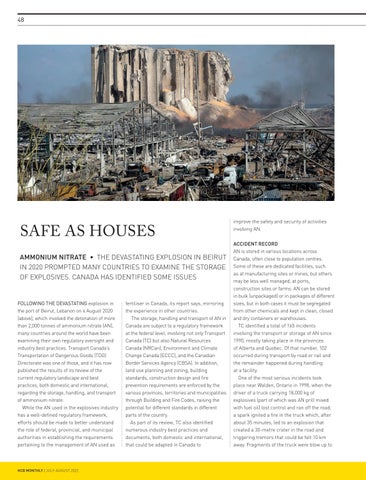48
SAFE AS HOUSES
improve the safety and security of activities involving AN.
FOLLOWING THE DEVASTATING explosion in the port of Beirut, Lebanon on 4 August 2020 (above), which involved the detonation of more than 2,000 tonnes of ammonium nitrate (AN), many countries around the world have been examining their own regulatory oversight and industry best practices. Transport Canada’s Transportation of Dangerous Goods (TDG) Directorate was one of those, and it has now published the results of its review of the current regulatory landscape and best practices, both domestic and international, regarding the storage, handling, and transport
fertiliser in Canada, its report says, mirroring the experience in other countries. The storage, handling and transport of AN in Canada are subject to a regulatory framework at the federal level, involving not only Transport Canada (TC) but also Natural Resources Canada (NRCan), Environment and Climate Change Canada (ECCC), and the Canadian Border Services Agency (CBSA). In addition, land use planning and zoning, building standards, construction design and fire prevention requirements are enforced by the various provinces, territories and municipalities
ACCIDENT RECORD AN is stored in various locations across Canada, often close to population centres. Some of these are dedicated facilities, such as at manufacturing sites or mines, but others may be less well managed, at ports, construction sites or farms. AN can be stored in bulk (unpackaged) or in packages of different sizes, but in both cases it must be segregated from other chemicals and kept in clean, closed and dry containers or warehouses. TC identified a total of 165 incidents involving the transport or storage of AN since 1990, mostly taking place in the provinces of Alberta and Quebec. Of that number, 102 occurred during transport by road or rail and the remainder happened during handling at a facility. One of the most serious incidents took place near Walden, Ontario in 1998, when the driver of a truck carrying 18,000 kg of
of ammonium nitrate. While the AN used in the explosives industry has a well-defined regulatory framework, efforts should be made to better understand the role of federal, provincial, and municipal authorities in establishing the requirements pertaining to the management of AN used as
through Building and Fire Codes, raising the potential for different standards in different parts of the country. As part of its review, TC also identified numerous industry best practices and documents, both domestic and international, that could be adapted in Canada to
explosives (part of which was AN prill mixed with fuel oil) lost control and ran off the road; a spark ignited a fire in the truck which, after about 35 minutes, led to an explosion that created a 30-metre crater in the road and triggering tremors that could be felt 10 km away. Fragments of the truck were blow up to
AMMONIUM NITRATE • THE DEVASTATING EXPLOSION IN BEIRUT IN 2020 PROMPTED MANY COUNTRIES TO EXAMINE THE STORAGE OF EXPLOSIVES. CANADA HAS IDENTIFIED SOME ISSUES
HCB MONTHLY | JULY-AUGUST 2022































